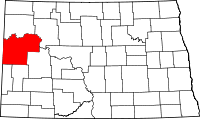Schafer, North Dakota
| Schafer | |
|---|---|
| Unincorporated area | |
|
Fenceline along a road in Schafer | |
 Schafer Location within the state of North Dakota | |
| Coordinates: 47°47′58″N 103°11′12″W / 47.79944°N 103.18667°WCoordinates: 47°47′58″N 103°11′12″W / 47.79944°N 103.18667°W | |
| Country | United States |
| State | North Dakota |
| County | McKenzie |
| Time zone | Central (CST) (UTC-6) |
| • Summer (DST) | CDT (UTC-5) |
Schafer is an unincorporated area and the former county seat of McKenzie County, North Dakota, United States. It faded into obscurity after the county seat was moved south to Watford City, and is now a ghost town. The town would still exist, but due to a land dispute in between the Schafer family and the Great Northern Railway, the railroad never laid tracks, but grading was done to the Missouri river.
The farm of Albert and Lulia Haven was located just to the north of Schafer, and it was there, in 1930, that Charles Bannon is believed to have murdered them both, along with their four children; for this he became the last man in the state of North Dakota to be lynched. The only remaining sign of the town is the old county jail, from which Bannon was dragged by the lynch mob on the night of his death.

